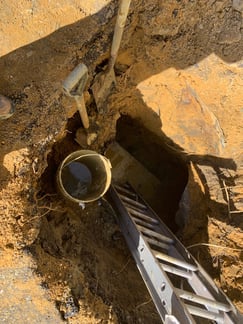What do you do with tanks that were previously abandoned in place?
The state construction code has always allowed tanks to be filled with an inert material, such as foam, sand or slurry. This is because many commercial tanks are large and may have structures built around them, making the tank removal economically unfeasible. (the tank could be removed but the cost would be excessive).

The concern regarding storage tanks is they can leak. When you remove a tank you can visually assess the tank for breaches and also by acquiring soil samples from the excavation the tank was removed from. You can also acquire soil samples from tanks that are abandoned in place.

The NJDEP in New Jersey, PADEP in Pennsylvania and DNREC in Delaware allow holes or coupons to be cut into tanks to obtain soil samples that are cleaned and proposed to be abandoned in place. Since commercial or regulated tanks have always had a soil sampling requirement the acquisition of soil samples below a tank has been commonly performed for decades on commercial sites. You see all commercial tanks must be tested as the environmental regulations require the tank to be shown not to have cleaned when a tank is removed or filled in place. The testing of residential tanks are more of a task performed so a property can be sold as no one wants to buy a contaminated property.
While homeowner's were not burdened by the soil sampling regulation, anyone hiring a licensed tank company would have been informed of the advantages of obtaining soil samples when a tank is filled in place. Tank owners would also be aware of the disadvantages of soil sampling, which simple put means you may find out you have a problem (Tank leak).
So it is more than likely that the property owner with the filled in place tank knew about soil sampling but chose not to do it. (The common response we get from property owners is that is filling the tank in place was legal, why test or do anything else.) From years of experience we have found that soil sampling was not performed on 90% of tanks that were filled in place.
The three most likely reason for not testing a tank
-
Owner did not want to test, to avoid finding a problem.
-
A non environmental company was hired to fill the tank in place, such as an HVAC, heating oil or plumbing company that was not familiar with soil testing (or licensed).
-
Company doing the work did not enter the tank to clean it (tank was pumped out), so if you don't enter the tank you can't cut holes in the bottom.

Why Fill a tank in place?
Many people with buried tanks decided to fill the tanks with sand or foam, when they stopped using them. The most informed, honest and proactive of these people acquired soil samples when the work was done, because they wanted to document that the tank did not leak. The vast majority of the people (90+%) did no testing. Either by choice they did not want to find a problem (we suspect 95%) and some because no one told them to. We suspect that any company filling a tank in place knew that you can sample under the tank as that is what we do for commercial tanks, people by a wide margin dint want to find a problem.
So fast forward to today, the house is being sold and buyers ask our opinion about the tank.
Remove and test the tank 100% of the time is our best advice.
If you do not having testing data from a tank, you do not know if it did or did not leak.
A small tank leak can cost $8,000.00

Expert Advice 888-301-1050
Filled in place tanks are like a box of chocolates, you never know what you are going to get. Many tanks that we remove, we find that the tank was not 100% cleaned and you have to get rid of oil contaminated sand or foam.

The darker sand came from the tank and was 100 impacted with oil because the tank was never cleaned.

This foam was removed from a tank that was not cleaned, black is the oil.

This tank was not cleaned either and you have a soupy mess of oily sand and water as the tank filled with water over the years.
What is the tank is abandoned under a structure? You reverse engineer the tank filling, meaning you extract all the fill, clean the tank again (many tanks were not 100% cleaned of oil) take soil samples and backfill the tank. In short you do what should have been completed when the tank was filled with sand.

This tank ran under the house, we had to extract soil from the end of the tank in the driveway, take the samples that should have been obtained when the tank was filled in place, then backfill the tank again. The samples cost $360.00, the work, several thousand.


Bottom line if you do not have paperwork Clearing Stating that the Testing revealed no Contamination, then you do not have whet you need.
Thousands of tank closed
Licensed in DE, PA and NJ
Over 20 years experience.
856-858-9509
